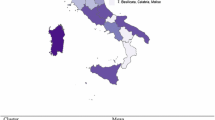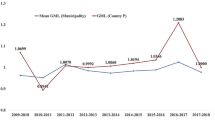Abstract
This article examines the health system performance impact of China’s new round of healthcare reform adopted in 2009. Specifically, we evaluated productivity and efficiency of health production pre- and post-reform period, compared the effects across all the 31 provinces of mainland China and identified potential determinants. As a major source of disability and premature mortality in China, non-communicable diseases (NCDs) had been the focus of our analysis, and the period during 2008–2015 was considered to allow enough time for the policy to have meaningful impact on the country’s health system. Productivity and efficiency performance were analyzed using a bootstrap** data envelopment analysis (DEA) and the Malmquist productivity index (MPI) techniques, while a Tobit regression technique was used to identify determinants of inefficiency. We find that after the reform efficiency and productivity had declined across large number of provinces. Mean overall technical efficiency (OTE) post 2009 was about 30% lower than the potential maximum capacity, while productivity also fell at a rate of 7.57% per annum. Trends in productivity and efficiency performance were largely linked to patterns of scale of technological change observed during the study period. The findings suggest that efficiency and productivity can be improved through enhancing financial security, optimizing health resource allocation, particularly between human resources for health and hospital beds, and expanding cost-effective technology within the health sector. Better urban planning practices and investment in education were also found to contribute to improved efficiency of NCDs services.


Similar content being viewed by others
References
Institute for Health Metrics and Evaluation: Global Burden of Disease Study 2016. http://ghdx.healthdata.org/gbd-results-tool (2016) Accessed 10 Dec 2018
Chai, P., Zhang, Y., Wan, Q., Guo, F., Zhai, T., Wang, C., Wang, X.: Estimation results of China curative care expenditure based on SHA 2011. Chin. Health Econ. 34(3), 17–19 (2015). https://doi.org/10.7664/CHE20150304
**ao, N., Long, Q., Tang, X., Tang, S.: A community-based approach to non-communicable chronic disease management within a context of advancing universal health coverage in China: progress and challenges. BMC Public Health 14(2), S2 (2014). https://doi.org/10.1186/1471-2458-14-s2-s2
Yip, W., Hsiao, W.C.: What drove the cycles of Chinese health system reforms? Health Syst. Reform 1(1), 52–61 (2015). https://doi.org/10.4161/23288604.2014.995005
Wu, L., Sun, Z., Shi, Z.: Public finance invests more than three trillion RMB in the health reform. In: Economic Information Daily, **nhua News Agency, Bei**g (2011)
Frieden, T.R.: A framework for public health action: the health impact pyramid. Am. J. Public Health 100(4), 590–595 (2010). https://doi.org/10.2105/AJPH.2009.185652
Feng, X., Liu, Y., Astell-Burt, T., Yin, P., Page, A., Liu, S., Liu, J., Wang, L., Zhou, M.: Analysis of health service amenable and non-amenable mortality before and since China’s expansion of health coverage in 2009. BMJ Open (2016). https://doi.org/10.1136/bmjopen-2015-009370
World Bank, the Development Research Center of the State Council P. R. China: China 2030: building a modern, harmonious, and creative society. World Bank, Washington, DC (2013)
World Bank Group, World Health Organization, Ministry of Finance, National Health and Family, Planning Commission, PRC and Ministry of Human Resources and Social Security, PRC: Deepening health reform in China building high-quality and value-based service delivery (2016)
Cylus, J., Papanicolas, I., Smith, P.C.: Using data envelopment analysis to address the challenges of comparing health system efficiency. Glob. Policy 8, 60–68 (2017). https://doi.org/10.1111/1758-5899.12212
An, Z., Yong, B.: Research on efficiency of Chinese medical health services–based on analysis of CD production function. Eur. Sci. J. ESJ 8(30), 87–94 (2012)
Zhang, X., Zhao, L., Cui, Z., Wang, Y.: Study on equity and efficiency of health resources and services based on key indicators in China. PLoS ONE 10(12), e0144809 (2015). https://doi.org/10.1371/journal.pone.0144809
Wu, S., Wang, C., Zhang, G.: Has China’s new health care reform improved efficiency at the provincial level? Evidence from a panel data of 31 Chinese provinces. J. Asian Public Pol. 8(1), 36–55 (2015). https://doi.org/10.1080/17516234.2015.1009399
Zhang, L., Cheng, G., Song, S., Yuan, B., Zhu, W., He, L., Ma, X., Meng, Q.: Efficiency performance of China’s health care delivery system. Int. J. Health Plan. Manag. 32(3), 254–263 (2017). https://doi.org/10.1002/hpm.2425
He, A.J., Qian, J.: Explaining medical disputes in Chinese public hospitals: the doctor-patient relationship and its implications for health policy reforms. Health Econ. Pol. Law 11(4), 359–378 (2016). https://doi.org/10.1017/s1744133116000128
Yip, W., Hsiao, W.: China’s health care reform: a tentative assessment. China Econ. Rev. 20(4), 613–619 (2009). https://doi.org/10.1016/j.chieco.2009.08.003
World Bank: Deepening health reform in China: building high-quality and value-based service delivery - policy summary (English). In: Vol. 1. vol. 107176. World Bank Group, Washington, DC (2016)
Li, X., Li, D., Huang, L.: The health production efficiencies and its changes of China- a comparative study base on DEA, SFA and Index of Malmquist. J. Appl. Stat. Manag. 33(5), 878–889 (2014)
**ao, H.X., Cao, T., Tang, L.: Measurement and analysis of government health expenditures and health efficiency. Chin. J. Health Pol. 7(11), 71–77 (2014)
Luo, L., Hu, M.: An analysis on the productive efficiency of China’s regional health and care services. Stat. Inf. Forum 23(2), 47–51 (2008)
Moran, V., Jacobs, R.: An international comparison of efficiency of inpatient mental health care systems. Health Policy 112(1), 88–99 (2013). https://doi.org/10.1016/j.healthpol.2013.06.011
Dzolkarnaini, N., Atkins, K.: Diabetes management: the association of wealth, spending and performance in Latin American and Caribbean countries. Int. J. Manag. Account. Res. 4(1), 69–91 (2014)
Varabyova, Y., Müller, J.-M.: The efficiency of health care production in OECD countries: a systematic review and meta-analysis of cross-country comparisons. Health Pol. 120(3), 252–263 (2016). https://doi.org/10.1016/j.healthpol.2015.12.005
Anthun, K.S., Kittelsen, S.A.C., Magnussen, J.: Productivity growth, case mix and optimal size of hospitals. A 16-year study of the Norwegian hospital sector. Health Pol. 121(4), 418–425 (2017). https://doi.org/10.1016/j.healthpol.2017.01.006
Jiang, N., Andrews, A.: Efficiency of New Zealand’s district health boards at providing hospital services: a stochastic frontier analysis. J. Prod. Anal. (2019). https://doi.org/10.1007/s11123-019-00550-z
Aletras, V., Kontodimopoulos, N., Zagouldoudis, A., Niakas, D.: The short-term effect on technical and scale efficiency of establishing regional health systems and general management in Greek NHS hospitals. Health Pol. 83(2), 236–245 (2007). https://doi.org/10.1016/j.healthpol.2007.01.008
Bhat, V.N.: Institutional arrangements and efficiency of health care delivery systems. Eur. J. Health Econ. 6(3), 215–222 (2005). https://doi.org/10.1007/s10198-005-0294-1
Gok, M.S., Altındağ, E.: Analysis of the cost and efficiency relationship: experience in the Turkish pay for performance system. Eur. J. Health Econ. 16(5), 459–469 (2015). https://doi.org/10.1007/s10198-014-0584-6
Felder, S., Tauchmann, H.: Federal state differentials in the efficiency of health production in Germany: an artifact of spatial dependence? Eur. J. Health Econ. 14(1), 21–39 (2013). https://doi.org/10.1007/s10198-011-0345-8
Erickson, P., Wilson, R., Shannon, I.: Years of healthy life. Healthy People 2000 Stat Notes. (7), 1–15 (1995). https://doi.org/10.1037/e583992012-001
Hyder, A.A., Rotllant, G., Morrow, R.H.: Measuring the burden of disease: healthy life-years. Am. J. Public Health 88(2), 196–202 (1998)
Charnes, A., Cooper, W.W., Rhodes, E.: Measuring the efficiency of decision making units. Eur. J. Oper. Res. 2(6), 429–444 (1978). https://doi.org/10.1016/0377-2217(78)90138-8
Banker, R.D., Charnes, A., Cooper, W.W.: Some models for estimating technical and scale inefficiencies in data envelopment analysis. Manag. Sci. 30(9), 1078–1092 (1984). https://doi.org/10.1287/mnsc.30.9.1078
Zofio, J.L.: Malmquist productivity index decompositions: a unifying framework. Appl. Econ. 39(18), 2371–2387 (2007). https://doi.org/10.1080/00036840600606260
Kounetas, K., Papathanassopoulos, F.: How efficient are Greek hospitals? A case study using a double bootstrap DEA approach. Eur. J. Health Econ. 14(6), 979–994 (2013). https://doi.org/10.1007/s10198-012-0446-z
Lothgren, M., Tambour, M.: Bootstrap** the data envelopment analysis Malmquist productivity index. Appl. Econ. 31(4), 417–425 (1999). https://doi.org/10.1080/000368499324129
StataCorp: Longitudinal-data/panel-data reference manual. Stata Press, Texas (2017)
Skinner, J., Staiger, D.: Technology diffusion and productivity growth in health care. Rev. Econ. Stat. 97(5), 951–964 (2015). https://doi.org/10.1162/REST_a_00535
Zhang, H., Liu, Y., Yang, Q., Gu, S., Zhen, X., **a, Y., Zhao, J., Yu, H., Dong, H.: A system dynamics simulation model of hierarchical medical care system reform in China. J. Health Med. Inform. (2017). https://doi.org/10.4172/2157-7420.1000253
Wu, D., Lam, T.P.: Underuse of primary care in China: the scale, causes, and solutions. J. Am. Board Fam. Med. 29(2), 8 (2016). https://doi.org/10.3122/jabfm.2016.02.150159
Beaglehole, R., Bonita, R., Horton, R., Adams, C., Alleyne, G., Asaria, P., Baugh, V., Bekedam, H., Billo, N., Casswell, S., Cecchini, M., Colagiuri, R., Colagiuri, S., Collins, T., Ebrahim, S., Engelgau, M., Galea, G., Gaziano, T., Geneau, R., Haines, A., Hospedales, J., Jha, P., Keeling, A., Leeder, S., Lincoln, P., McKee, M., Mackay, J., Magnusson, R., Moodie, R., Mwatsama, M., Nishtar, S., Norrving, B., Patterson, D., Piot, P., Ralston, J., Rani, M., Reddy, K.S., Sassi, F., Sheron, N., Stuckler, D., Suh, I., Torode, J., Varghese, C., Watt, J.: Priority actions for the non-communicable disease crisis. Lancet 377(9775), 1438–1447 (2011). https://doi.org/10.1016/s0140-6736(11)60393-0
Zhang, Y., Wan, Q., Chai, P., Guo, F., Zhai, T., Wang, C., Wang, X.: The economic burden of NCDs and their impact on economy. Chin. Health Econ. 34(03), 12–16 (2015)
OECD: Health at a Glance 2015: OECD Indicators. OECD Publishing, Paris, (2015). https://doi.org/10.1787/health_glance-2015-en
He, D., Yu, H., Chen, Y.: Equity in the distribution of CT and MRI in China: a panel analysis. Int. J. Equity Health 12(1), 39 (2013). https://doi.org/10.1186/1475-9276-12-39
Zhang, J.: Application and approval of cancer drugs in China: acceleration should be kept in progress. AME. Med. J. 3(4), 1–3 (2018). https://doi.org/10.21037/amj.2018.04.04
Weisbrod, B.A.: The health care quadrilemma: an essay on technological change, insurance, quality of care, and cost containment. J. Econ. Lit. 29(2), 523–552 (1991)
Hollingsworth, B., Wildman, J.: The efficiency of health production: re-estimating the WHO panel data using parametric and non-parametric approaches to provide additional information. Health Econ. 12(6), 493–504 (2003). https://doi.org/10.1002/hec.751
Hsu, Y.-C.: The efficiency of government spending on health: evidence from Europe and Central Asia. Soc. Sci. J. 50(4), 665–673 (2013). https://doi.org/10.1016/j.soscij.2013.09.005
Lee, J. Y.: Global trends of productivity growth: evidence from the Malmquist index (June 30, 2008). East Asian Econ. Rev. 12(1), 111–137 (2008). https://papers.ssrn.com/sol3/papers.cfm?abstract_id=3077843
Ng, Y.C.: The productive efficiency of the health care sector of China. Rev. Reg. Stud. 38(3), 381–393 (2008)
The State Council the People’s Republic of China: Nation to promote Internet Plus healthcare. http://english.gov.cn/premier/news/2018/04/12/content_281476109872514.htm (2018). Accessed 11–19 2018
Anderson, G.F., Frogner, B.K., Johns, R.A., Reinhardt, U.E.: Health care spending and use of information technology in OECD countries. Health Aff. 25(3), 819–831 (2006). https://doi.org/10.1377/hlthaff.25.3.819
Bardhan, I.R., Thouin, M.F.: Health information technology and its impact on the quality and cost of healthcare delivery. Decis. Support Syst. 55(2), 438–449 (2013). https://doi.org/10.1016/j.dss.2012.10.003
Kinfu, Y., Sawhney, M.: Inefficiency, heterogeneity and spillover effects in maternal care in India: a spatial stochastic frontier analysis. BMC Health Serv. Res. 15, 118 (2015). https://doi.org/10.1186/s12913-015-0763-x
Bollen, K.A., Ward, S.: Ratio variables in aggregate data analysis: their uses, problems, and alternatives. Sociol. Methods Res. 7(4), 431–450 (1979). https://doi.org/10.1177/004912417900700405
Acknowledgements
The authors are very thankful to the reviewers for their helpful remarks and suggestions.
Funding
This research did not receive any specific grant or funding from public, commercial, or not-for-profit sector.
Author information
Authors and Affiliations
Corresponding author
Ethics declarations
Conflict of interest
None.
Additional information
Publisher's Note
Springer Nature remains neutral with regard to jurisdictional claims in published maps and institutional affiliations.
Rights and permissions
About this article
Cite this article
Chai, P., Wan, Q. & Kinfu, Y. Efficiency and productivity of health systems in prevention and control of non-communicable diseases in China, 2008–2015. Eur J Health Econ 22, 267–279 (2021). https://doi.org/10.1007/s10198-020-01251-3
Received:
Accepted:
Published:
Issue Date:
DOI: https://doi.org/10.1007/s10198-020-01251-3




